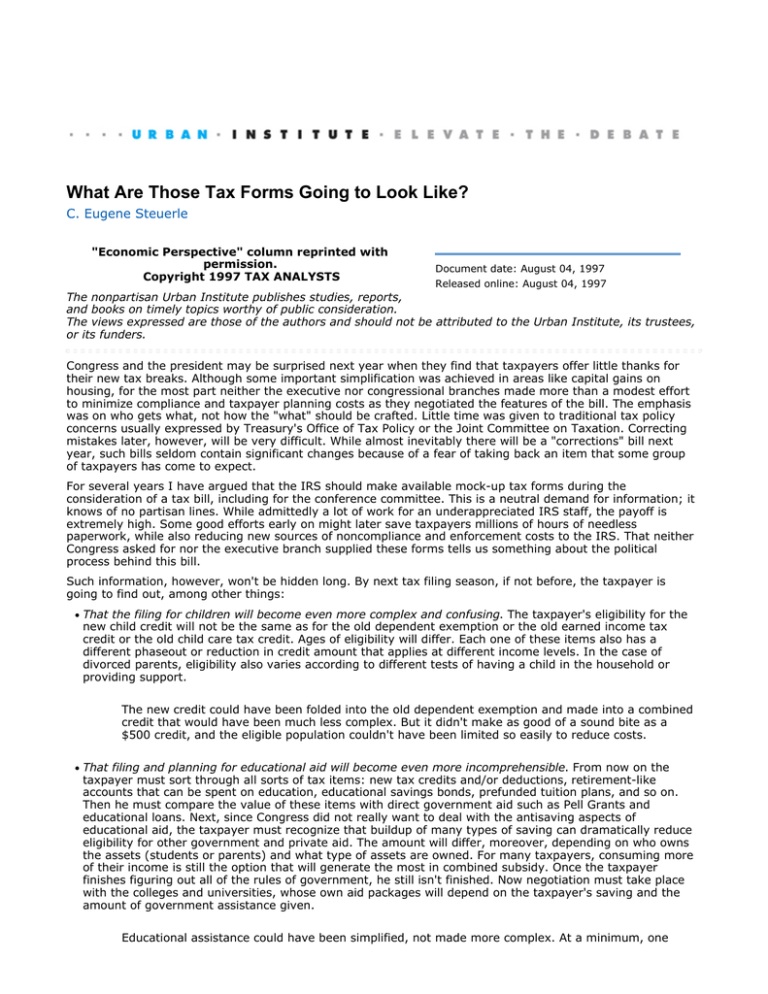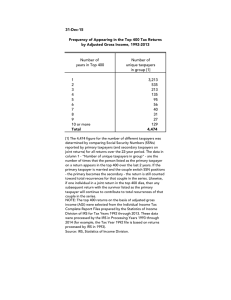What Are Those Tax Forms Going to Look Like?
advertisement

What Are Those Tax Forms Going to Look Like? C. Eugene Steuerle "Economic Perspective" column reprinted with permission. Copyright 1997 TAX ANALYSTS Document date: August 04, 1997 Released online: August 04, 1997 The nonpartisan Urban Institute publishes studies, reports, and books on timely topics worthy of public consideration. The views expressed are those of the authors and should not be attributed to the Urban Institute, its trustees, or its funders. Congress and the president may be surprised next year when they find that taxpayers offer little thanks for their new tax breaks. Although some important simplification was achieved in areas like capital gains on housing, for the most part neither the executive nor congressional branches made more than a modest effort to minimize compliance and taxpayer planning costs as they negotiated the features of the bill. The emphasis was on who gets what, not how the "what" should be crafted. Little time was given to traditional tax policy concerns usually expressed by Treasury's Office of Tax Policy or the Joint Committee on Taxation. Correcting mistakes later, however, will be very difficult. While almost inevitably there will be a "corrections" bill next year, such bills seldom contain significant changes because of a fear of taking back an item that some group of taxpayers has come to expect. For several years I have argued that the IRS should make available mock-up tax forms during the consideration of a tax bill, including for the conference committee. This is a neutral demand for information; it knows of no partisan lines. While admittedly a lot of work for an underappreciated IRS staff, the payoff is extremely high. Some good efforts early on might later save taxpayers millions of hours of needless paperwork, while also reducing new sources of noncompliance and enforcement costs to the IRS. That neither Congress asked for nor the executive branch supplied these forms tells us something about the political process behind this bill. Such information, however, won't be hidden long. By next tax filing season, if not before, the taxpayer is going to find out, among other things: That the filing for children will become even more complex and confusing. The taxpayer's eligibility for the new child credit will not be the same as for the old dependent exemption or the old earned income tax credit or the old child care tax credit. Ages of eligibility will differ. Each one of these items also has a different phaseout or reduction in credit amount that applies at different income levels. In the case of divorced parents, eligibility also varies according to different tests of having a child in the household or providing support. The new credit could have been folded into the old dependent exemption and made into a combined credit that would have been much less complex. But it didn't make as good of a sound bite as a $500 credit, and the eligible population couldn't have been limited so easily to reduce costs. That filing and planning for educational aid will become even more incomprehensible. From now on the taxpayer must sort through all sorts of tax items: new tax credits and/or deductions, retirement-like accounts that can be spent on education, educational savings bonds, prefunded tuition plans, and so on. Then he must compare the value of these items with direct government aid such as Pell Grants and educational loans. Next, since Congress did not really want to deal with the antisaving aspects of educational aid, the taxpayer must recognize that buildup of many types of saving can dramatically reduce eligibility for other government and private aid. The amount will differ, moreover, depending on who owns the assets (students or parents) and what type of assets are owned. For many taxpayers, consuming more of their income is still the option that will generate the most in combined subsidy. Once the taxpayer finishes figuring out all of the rules of government, he still isn't finished. Now negotiation must take place with the colleges and universities, whose own aid packages will depend on the taxpayer's saving and the amount of government assistance given. Educational assistance could have been simplified, not made more complex. At a minimum, one could easily have expanded use of existing direct aid mechanisms, and, if saving incentives were desired, relaxed the asset tests applying to those expenditures. But it didn't make as good of a sound bite as a new educational tax credit or loan, and it couldn't have been enacted as part of a tax cut. That filing and planning for capital gains taxation will become much more important and pervasive. For those with substantial gains, of course, little protest can be expected. After all, many of these individuals typically pay for tax return preparation, and additional preparation costs are liable to be small relative to the new tax saving. For taxpayers with only modest amounts of gains, however, the filing costs will be more burdensome. An average-income mutual fund owner, for instance, will discover that many more calculations are required than under old law, especially if there are frequent sales and purchases from the fund -- as in the case of those who write checks against their accounts on a regular basis. More important than the additional tax filing obligations, however, will be the large degree to which tax planning -attempts to convert or re-label ordinary income as capital gains -- grows in importance. If experience of the 1980s is any indication, moreover, the planning will unnecessarily influence many individuals who are carried along by the general advertising, even though they really have inadequate tax reasons to engage in expensive transactions to try to minimize taxation. Any capital gains reduction would probably have added some complexity, but there were ways of building a system that could even have reduced planning distortions and been more in keeping with other tax policy principles. For instance, providing some credit against capital gains tax to individual taxpayers for corporate taxes paid would have worked to reduce the unequal taxation and related planning costs surrounding partnership versus corporate ownership. But it didn't make as good of a sound bite as an across-the-board capital gains tax cut, and it wouldn't have created as long a list of political winners. That filing and planning for American Dream Savings Accounts will become a complex part of everyone's personal saving and retirement saving calculations. For most, there will be no clear-cut answer as to whether saving should go in this account or into normal individual retirement accounts or a whole slew of other savings that enjoy tax preference. For savers uncertain about the direction of tax laws, therefore, one likely bet will be to diversify -- creating an even greater number of accounts that must be traced and tracked over time. For the IRS, lifetime accounting will now be required to trace through the deposits, buildup of earnings, and withdrawals from these special accounts. Substantial negotiations will take place with the banking and mutual fund industries to try to figure out how to pass information back and forth. Higher levels of saving incentives could easily have been added to existing parts of the tax laws without any increase in complexity. But it wouldn't have made as good of a sound bite as yet another, newer, different saving incentive. Expect the popular press to begin stories on tax planning almost immediately. Then early next year, the stories on tax filing complexity will hit the stands. None of these stories is likely to convey the impression of a job well done. Other Publications by the Authors C. Eugene Steuerle Usage and reprints: Most publications may be downloaded free of charge from the web site and may be used and copies made for research, academic, policy or other non-commercial purposes. Proper attribution is required. Posting UI research papers on other websites is permitted subject to prior approval from the Urban Institute—contact publicaffairs@urban.org. If you are unable to access or print the PDF document please contact us or call the Publications Office at (202) 261-5687. Disclaimer: The nonpartisan Urban Institute publishes studies, reports, and books on timely topics worthy of public consideration. The views expressed are those of the authors and should not be attributed to the Urban Institute, its trustees, or its funders. Copyright of the written materials contained within the Urban Institute website is owned or controlled by the Urban Institute. Source: The Urban Institute, © 2012 | http://www.urban.org
